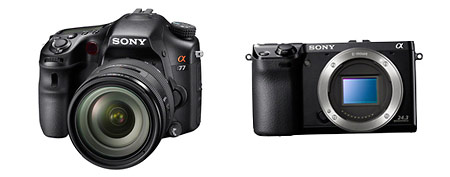Sony was a latecomer to digital SLRs. But don’t let that fool you into thinking they don’t have game. About six years ago they bought all of Konica-Minolta’s digital SLR patents and a few months later they released their digital SLR, the Sony Alpha A100. There was a lot of skepticism about Sony’s ability to make a competitive digital SLR. But the A100 showed the doubters that Sony was serious and capable. Sony has since proved their commitment to the digital SLR market after their last round of announcements (August 2011) they’ve arguably become the most innovative DSLR manufacturer. They’re the only camera maker to compete with Canon and Nikon in the full-frame, pro digital SLR space and in the past two years they introduced the award-winning transparent mirror Alpha SLT line and the Alpha NEX mirrorless interchangeable lens cameras. There’s no doubt Nikon and Canon are watching their rearview mirrors closely because Sony is coming up fast and looking to make that pass. As far as technology goes, some might say they’ve already made the pass.
Take Me Straight To The Cameras >>
One of the main benefits of choosing Sony over Nikon or Canon is all their digital SLRs include Sony’s excellent SteadyShot built-in image stabilization. So no matter what lens you use on a Sony digital SLR, you’ll get sharper photos in low light and with longer lenses. Nikon and Canon users need to buy special “VR” and “IS” lenses to get the same benefits. Sony is also the only camera maker that offers the same auto focus performance regardless of whether you’re shooting stills or movies. And for regular folks who want digital SLR performance, Sony’s mass-market experience means the Sony Alpha cameras are intuitive and easy to use.
With the exception of the full-frame 24.6-megapixel Alpha A900, all of Sony’s digital SLRs APS-C sensor (smaller sensor) cameras with a 1.5x crop factor. Sony’s new Alpha SLT cameras (Single Lens Translucent) have an electronic viewfinder (EVF) and a fixed, transparent mirror instead of a hinged mirror like most SLR cameras. The transparent mirror allows the camera to use faster, more accurate phase detect auto focus in live view and movie mode as well as for still photos. That gives the Sony SLT cameras the most effective movie mode auto focus of any currently available camera as well as allowing faster burst speeds than comparably priced competitor cameras.

Sony’s Latest & Greatest – The Sony Alpha SLT-A77 And The Sony Alpha NEX-7
The Sony Alpha NEX compact mirrorless camera line also deserves mention. With the exception of the very special NEX-7, the NEX cameras aren’t individually detailed in this guide because, technically, they actually aren’t digital SLRs. But they use the same sensors as Sony DSLRs and can use Sony Alpha lenses with an adapter. In fact, Sony just introduced a new lens converter, the LA-EA2 Mount Adaptor which adds a mirror and phase detect auto focus to the NEX cameras, effectively converting them into digital SLRs.
You can’t discuss digital SLRs without also talking about lenses. Sony doesn’t have as many SLR lenses as Nikon and Canon but they’ve done a great job of building up the lens selection and making sure there are lenses to meet everyone’s needs. There are almost 30 Sony lenses now, including five premium Carl Zeiss lenses, three macro primes, and Sony’s fast aperture G-Series pro lens line. And since Sony bought the Maxxum lens mount patent from Konica Minolta, there’s also a whole world of used Konica Minolta glass to be had on Craig’s List and eBay.
Below, you’ll find descriptions of all the current Sony Alpha digital SLRs, including basic features and specs as well as links to reviews, shopping and any other related articles we might have. If you have any questions, you can post them either on the Sony Camera Forum or in the comments section at the bottom of each page in this guide. And if you’re a Sony Alpha digital SLR owner, please take a few minutes to write a review in our user reviews.
|
|||||
|
Sony Alpha A390 |
|||

|
|
||
|
|||
|
|||||
|












Nice guide John
Thanks, Greg. It got kind of out of hand. I didn’t intend the inro to be so long but I thought the Sony system needed more introduction than Nikon and Canon, since Sony is a relative newcomer to the camera business and some of their technology is probably mysterious to the average camera shopper.